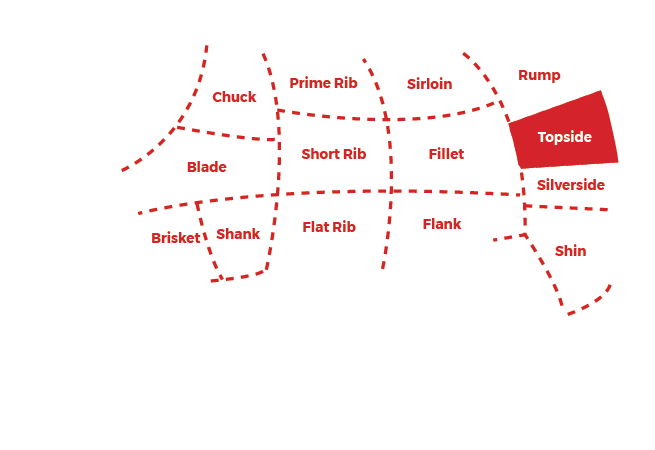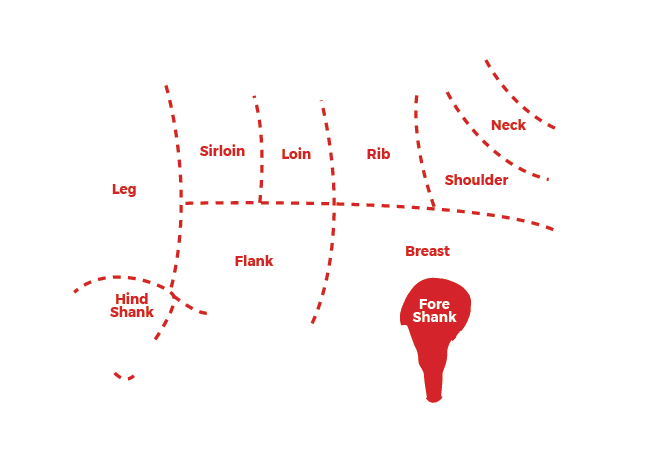Meat Cuts

Chuck
This cut from the base of the neck is one that can be extremely tasty whole or sliced. It has a high proportion of connective tissue. It can be a bit tough, but slow cooking means that it will fall of the bone and be tender.
RECOMMENDED METHODS:
1. Braising
2. Pot Roasting.

Prime Rib
This cut is highly regarded as one of the best cuts of meat. It can be roasted whole or sliced thickly (3cm) to be used as a Prime Rib steak. Bone-in cuts tend to give a dish more flavour when cooked and this cut has a great deal of tenderness to it too. The end closest to the Sirloin is sliced as Club Steak and the deboned version of this is known as Ribeye Steak.
RECOMMENDED METHODS:
1. Sliced- on the braai or grilled whole
2. Roasted or braised in the oven.

Sirloin
This cut is one of the more popular steaks in SA. It is also known as Porterhouse steak or Striploin and is characterised by a strip of fat on the outside. The meat is tender with a fine texture and is often ‚aged‚ further in vacuum bags for up to 3 weeks to increase the tenderness. It can also be sliced as steaks on the bone, these are called Junior T-Bone steak and T- Bone steak (with fillet).
RECOMMENDED METHODS:
1. 2-3cm thick steaks grilled on a skillet or on the braai at a high heat

Rump
This cut consists of a few loosely connected muscles and the pelvic bone. In SA this is deboned and sliced into rump steak. A perennial favourite on the South African braai, it is well regarded for great flavour and tenderness. Rump can be wet aged in vacuum bags for up to 3 weeks to ensure tenderness.
RECOMMENDED METHODS:
1. Steaks cut 2-3cm grilled in a skillet or on the braai over a high heat.

Blade
This cut comes from the shoulder of the forequarter and is best used in dishes that you cook with liquid such as stock, red wine and beer. It has a rich deep flavour and is used in many traditional French dishes where slow cooking and simple ingredients are required.
RECOMMENDED METHODS:
1. Casserole
2. Stewing
3. Braising

Short Rib
This cut is located just under the Prime Rib and forms part of the rib cage. As it is intercostal muscle, the meat is slightly on the tough side but is packed with the most delicious flavour. The correct cooking methods will ensure that it is soft and tender. This is one of the favourites on the braai in Argentina, arguably the best producer of beef in the world.
RECOMMENDED METHODS:
1. Parboil the ribs, marinade and then put on the Braai
2. Braise in a liquid like stock, wine or beer.

Fillet
This meat, extremely versatile in culinary terms, is situated internally behind the sirloin. Being the most tender cut of beef, it is widely used in restaurants and is known for being more expensive than other cuts.
RECOMMENDED METHODS:
1. Whole-Roasted Steaks 2-3cm thick-pan fried
2. Grilled or braaied at high heat

Topside
A versatile cut that is most used in making lean mince as well as Tenderised Steak and Roast Beef. It is generally a lean cut of beef that can also be used in the manufacturing of sausages and types of boerewors.
RECOMMENDED METHODS:
- Roasting
- Mince for burgers
- Meatballs etc
- Boerewors on the braai

Brisket
This cut would be the equivalent of the chest of the forequarter. It is generally a tough cut of meat but has a great deal of flavour. When cooked for a few hours in a pot or in the oven it becomes very tender. The flavour comes about as a result of there being a great deal of ‚marbling‚ this means that there is a higher proportion of fat within the meat, adding flavour when it cooks.
RECOMMENDED METHODS:
Sliced on the braai whole/deboned-braised, grilled or pot roasted.

Shank
Beef shanks are a cut that have a section of leg bone, along with the meat that surrounds the bone. Beef shanks are one of the most underrated cuts of beef in our book. They’re super affordable and super tasty.

Flat Rib
This cut is situated below the Short Rib and is often found pre marinaded in bags. This is always a winner for festive occasions and on the braai it is always delicious.
RECOMMENDED METHODS:
Marinated and on the braai

Flank
This cut is usually minced to go into mince or burger patties but is also used for different types of boerewors. It can also be trimmed and cut into thin Flank steaks. The meat has a coarse texture but distinct flavour that is revered in various cuisines around the world.
RECOMMENDED METHOD:
Steaks-fried, grilled or braaied over a medium heat

Silverside
This cut is located on the inside of the buttock and is called silverside due to a shiny membrane that encases the whole primal cut. The top part of the silverside, closest to the rump is known as the Aitchbone, this is often used for roasting.
RECOMMENDED METHODS:
1. Aitchbone for Roasting
2. Tenderised steaks for braaing and grilling
3. Beef Schnitzel
4. Prego
5. Steak Rolls
6. Biltong

Shin
This cut from the base of the neck is one that can be extremely tasty whole or sliced. It has a high proportion of connective tissue. It can be a bit tough, but slow cooking means that it will fall of the bone and be tender.
RECOMMENDED METHODS:
1. Braising
2. Pot Roasting

Neck
Some people will cook Chicken necks and clean the meat off of them for soup or for the dogs, while others will discard Chicken necks entirely. In either case they can be used to make an exceptionally flavourful stock.

Breast
Chicken breast must be the most versatile meat. It is a white meat with very little fat and it is the perfect cut to slice up in stir-fries, marinate and grill, pan-fry or oven roast, filled with your favourite filling. Chicken breasts can also be baked or poached and used in salad, sandwiches or shredded and put into soups.

Tenderloin
Chicken tenderloins are lean and take well to several cooking methods. If you avoid using oil or sodium-rich ingredients, these cuts are healthful enough to eat regularly.

Back
Chicken backs are the core of the chicken that is left after the breast, wings, and legs have been cut away for parts. Our chicken backs are fairly meaty and are typically used to make broth and to harvest the remaining meat.

Wing
Wings work fantastically as a snack or starter especially with a sweet and sticky sauce or marinade. Grilled or put onto the braai they are delicious. They can also be sold as Chicken Drumettes where this is the first joint of the wing.
RECOMMENDED METHODS:
1. Marinated and grilled or braaied

Tail
The tail contains a lot of fat, but no toxins or carcinogens. Oestrogen is fat soluble and the chicken tail contains a lot of fat.
Overall, eating chicken tail as part of a varied diet containing many different kinds of food will have no health consequences.

Thigh
Thigh meat is also dark and like the drumstick, has a great deal of flavour. It is also as versatile as its leg counterpart, with a lovely firm and juicy texture. They can be put into stews, curries, casseroles or even put on the braai.
RECOMMENDED METHODS:
1. Marinated and grilled or braaied
2. Put into Casseroles

Drumstick
The dark meat of the leg or drumstick is regarded as one of the tastiest parts of the chicken. It is juicy and can be used in a whole number of ways ranging from stews or curries, to oven baked and braais.
RECOMMENDED METHODS:
1. Marinated and grilled or braaied
2. Put into casseroles
3. Curries or stews

Neck
This cut is generally sliced on the bandsaw and used for stewing or curries. As it is on the bone, slow cooking is necessary for the meat to become soft and tender. It has a deep, rich flavour when cooked as there is a high content of fat in the meat.
RECOMMENDED METHODS:
1. Stews, curries, potjies

Lamb
Lamb chops are a versatile cut that works really well sliced and also slow cooked whole or deboned and cubed. The shoulder has a high amount of connective tissue so when it is cooked for a long time it falls off the bone, tender and delicious.
RECOMMENDED METHODS:
1. Chops grilled or put on the braai
2. Roasted whole, deboned, cubed for curries or stews

Rib
The ribs are often sliced and put into stewing lamb that is available at the retail outlets. They also make the most fantastic snacks on the braai, sliced and marinated.
RECOMMENDED METHODS:
1. Stewing
2. Sliced and put on the braai.

Loin
The loin is sliced into chops and these are what you will see on restaurants‚ menus when‚ lamb chops‚ are served. The meat is tender and a great deal of flavour comes from the fat on the outside of the chop. When grilled, a lot of the fat cooks away but in the process adds flavour to the meat.
RECOMMENDED METHODS:
1. Grilled in a pan or on a braai

Sirloin
The lamb sirloin is sometimes considered part of the leg primal cut, but it can also be prepared separately. In this case, it is frequently cut into chops or steaks and cooked using dry heat.
Lamb sirloin is the cut of meat located just in front of the lamb leg and is sometimes sold along with the leg. Often cut into steaks or chops, it can also be purchased as a boneless roast. A 3-ounce serving of roasted lamb sirloin is an excellent source of protein, vitamin B-12, niacin and zinc.

Leg
This cut has a whole host of different uses and is great for festive occasions or gatherings with friends and family.
Marinating is important with a leg as it absorbs a whole host of different flavours. Some of the best ones to use are garlic, thyme, rosemary and yoghurt.
RECOMMENDED METHODS:
1. Sliced and grilled as leg chops
2. Roasted whole or deboned and butterflied
3. Cubed put into stews and curries

Hind Shank
The shank is the cut of lamb taken from the lower section of the animal’s legs and can be from the front legs (foreshank) or the back legs (hind shank). The foreshank may include part of the shoulder, as well as part of the leg, while the hind shank will include only part of the rear leg.

Flank
A fatty, but incredibly tender cut of meat, the belly is delicious when slow-roasted. It’s also used to make streaky bacon. Pork belly is very high in fat, which makes it a delicious and versatile cut. It can be cooked slowly at a low temperature for soft meat that melts in the mouth, or it can be sliced and crisped up in a hot pan. It can also be roasted or stewed, but make sure you skim away some of the fat. As a robust cut, it works well paired with aromatic flavours and Asian spices.

Breast
Breast of lamb is cut from the belly of the lamb; it is a great cut for those with little experience cooking lamb but wish to yield maximum taste. Although lamb breast has a higher fat content than some other lamb cuts when slow-cooked much of the fat is released during cooking, collected and discarded.
Lamb breast is a value cut that is often underused as it has quite a lot of fat and can be tough if cooked incorrectly. Treat as you would pork belly and you’re away to go — the layer of fat brings oodles of flavour and helps to tenderise the meat as it cooks.

Fore Shank
Lamb Shanks come from the front legs of the lamb. They can either be sliced or cooked whole. As with the shoulder of lamb, there is a high amount of connective tissue which results in incredibly tasty meat that falls off the bone when cooked.
RECOMMENDED METHODS:
1. Roasted or braised whole sliced and cooked in curries or stews

Neck
From the neck there are a whole lot of different culinary uses. It has a wonderful amount of connective tissue and is delicious sliced into steaks and then slow roasted. It can be pickled and smoked where you would have Boston Butt, Kentucky Ham (netted) or sliced as neck bacon.
RECOMMENDED USES:
1. Neck Bacon- grilled or fried
2. Boston Butt/Kentucky Ham – simmered and then glazed
3. Steaks can be grilled in the oven or slow roasted in oven

Blade
The blade roast is a well-marbled cut. This versatile cut can be pot-roasted whole, cut up for stews or cooked over moist smoke in a smoker to transform it into classic pulled pork barbecue.
Whether it is roasted, braised or barbecued, blade roast becomes meltingly tender and deliciously flavorful.

Shoulder
The shoulder has many uses but one of its most important uses for it is in manufacturing of good quality processed products like sausages and frankfurters. Shoulder bacon can also be made as well as the whole shoulder being roasted, bone-in or deboned. It can also be pickled and smoked as a shoulder or boneless gammon.
RECOMMENDED METHODS:
1. Grilled or fried as pork sausages,
2. Roasted or braised as a whole shoulder
3. Shoulder bacon – grilled or fried

Loin
The loin is characterised by a lean medallion of meat and a solid strip of fat on the outside. The loin can be sliced on the bone to get pork loin chops, pickled and smoked to make Kassler chops or deboned, pickled and smoked to make back bacon. It can also be rolled and roasted in the oven to make a delicious roast loin of pork.
RECOMMENDED METHODS:
1. Grilled pork chops
2. Grilled Kassler chops
3. Oven roasted rolled pork
4. Back bacon – grilled or fried

Spareribs
Ribs on the braai are most certainly one of the delicious things around. They can be bought smoked or marinated and are especially loved by the younger members of the family.
RECOMMENDED METHODS:
1. Marinated and grilled in the oven or on the braai

Belly
The belly is another versatile cut of the pig that has various functions and uses. It is deboned and the bone part leftover is used as Spare Ribs. The belly can both be rolled and roasted whole with the rind on so that it crisps up into crackling. It is also pickled and smoked to be sliced as Streaky Bacon. Another use is that it gets sliced on the bone as Pork Rashers.
RECOMMENDED METHODS:
1. Rolled and roasted as roast pork belly
2. Streaky bacon – grilled or fried
3. Rashers on the braai

Leg or Ham
The leg has many uses and is often pickled, smoked or used in manufacturing of hams. The shank can also be pickled and smoked. The leg is also great as a roast and with the skin still on this forms the crispy crackling everyone loves! Leg Gammons are also another use for this cut especially over the festive season.
RECOMMENDED METHODS:
1. Roasted in oven as pork leg roast
2. Simmered and glazed as leg gammon
3. Shanks braised, roasted or simmered





